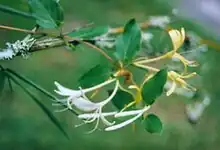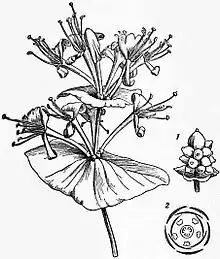Caprifoliaceae
The Caprifoliaceae or honeysuckle family is a clade of dicotyledonous flowering plants consisting of about 860 species,[3] in 33,[2] to 42 genera, with a nearly cosmopolitan distribution. Centres of diversity are found in eastern North America and eastern Asia, while they are absent in tropical and southern Africa.
| Caprifoliaceae | |
|---|---|
 | |
| Lonicera japonica | |
| Scientific classification | |
| Kingdom: | Plantae |
| Clade: | Tracheophytes |
| Clade: | Angiosperms |
| Clade: | Eudicots |
| Clade: | Asterids |
| Order: | Dipsacales |
| Family: | Caprifoliaceae Juss.[1] |
| Type genus | |
| Lonicera | |
| Genera | |
|
See text | |
| Synonyms[2] | |
|
Dipsacaceae Juss., Gen. Pl. [Jussieu] 194. 1789 [4 Aug 1789] (1789) nom. cons. | |
Description
The flowering plants in this clade are mostly shrubs and vines: rarely herbs. They include some ornamental garden plants grown in temperate regions. The leaves are mostly opposite with no stipules (appendages at the base of a leafstalk or petiole), and may be either evergreen or deciduous. The flowers are tubular funnel-shaped or bell-like, usually with five outward spreading lobes or points, and are often fragrant. They usually form a small calyx with small bracts. The fruit is in most cases a berry or a drupe. The genera Diervilla and Weigela have capsular fruit, while Heptacodium has an achene.
Taxonomy
Views of the family-level classification of the traditionally accepted Caprifoliaceae and other plants in the botanical order Dipsacales have been considerably revised in recent decades. Most botanists now accept the placement of two of the most familiar members of this group, the elderberries (Sambucus) and the viburnums (Viburnum), in the family Adoxaceae instead; these were formerly classified here.
Several other families of the more broadly treated Caprifoliaceae s.l. are separated by some but not all authors; these are treated as subfamilies in the listing of selected genera below,[3] along with estimated numbers of species.

Diervilloideae
Caprifolioideae s.s.
- Heptacodium (seven-son flower): 1 species
- Leycesteria: 6 species
- Lonicera (honeysuckle): 180 species
- Symphoricarpos (snowberry): 17 species
- Triosteum (horse gentian): 6 species
Linnaeoideae
- Abelia: 30 species
- Dipelta: 4 species
- Kolkwitzia (beautybush): 1 species
- Linnaea (twinflower): 1 species
Morinoideae
- Acanthocalyx: 3 species
- Cryptothladia
- Morina
- Zabelia
Dipsacoideae
- Bassecoia
- Cephalaria
- Dipsacus (teasel): 15 species
- Knautia
- Lomelosia: 63 species
- Pterocephalus: 25 species
- Scabiosa (scabious, pincushion flower): 30 species
- Succisa
- Succisella
- Triplostegia
Valerianoideae
- Centranthus: 12 species
- Fedia
- Nardostachys : 3 species
- Patrinia: 17 species
- Plectritis (seablushes): 5 species
- Valeriana (valerians): 125 species
- Valerianella (cornsalads): 20 species
Uses
The plants belonging to this family are mainly hardy shrubs or vines of ornamental value, many of which are popular garden shrubs, notably species belonging to the genera Abelia, Lonicera, and Weigela. Valerianella locusta is cultivated for use in food.
A few, however, have become invasive weeds outside their native ranges (such as Lonicera japonica).
References
- Angiosperm Phylogeny Group (2009). "An update of the Angiosperm Phylogeny Group classification for the orders and families of flowering plants: APG III". Botanical Journal of the Linnean Society. 161 (2): 105–121. doi:10.1111/j.1095-8339.2009.00996.x.
- "Caprifoliaceae Juss. | Plants of the World Online | Kew Science". Plants of the World Online. Retrieved 19 August 2022.
- "Angiosperm Phylogeny Website".